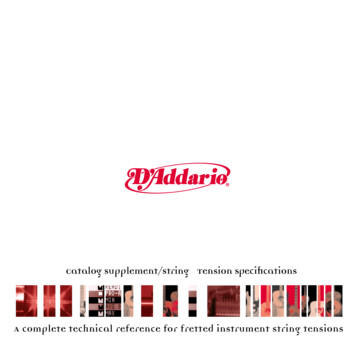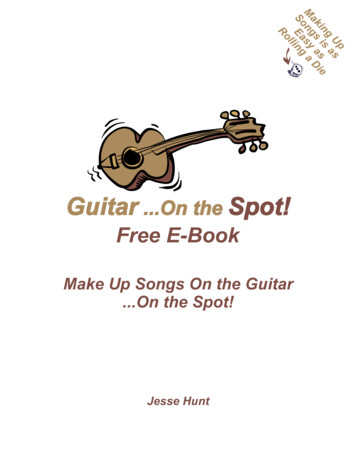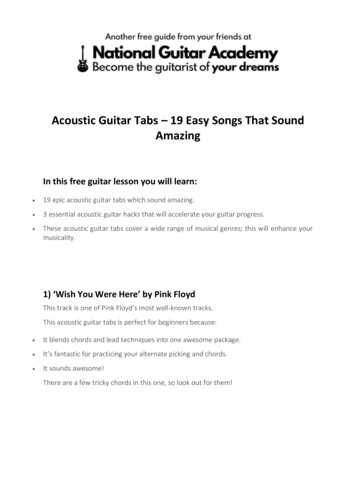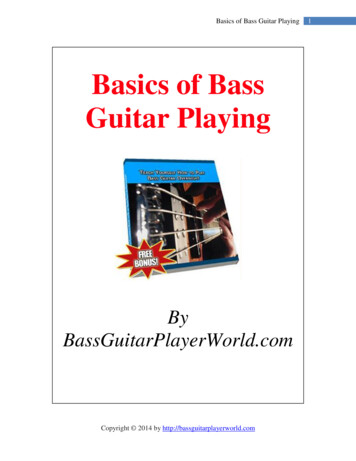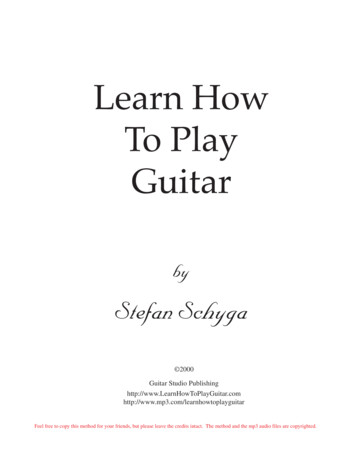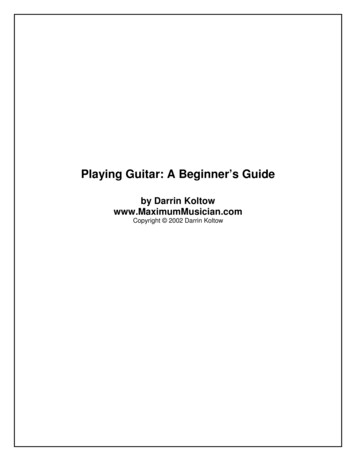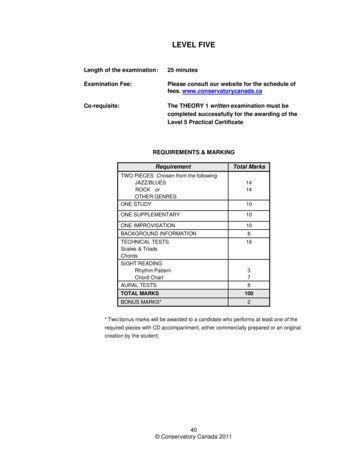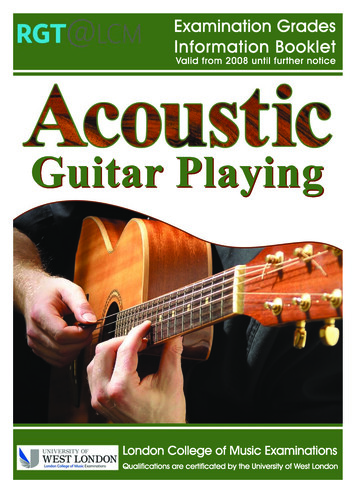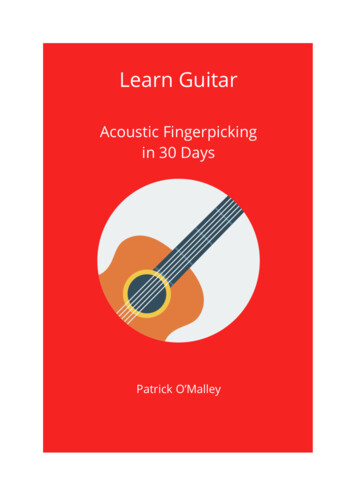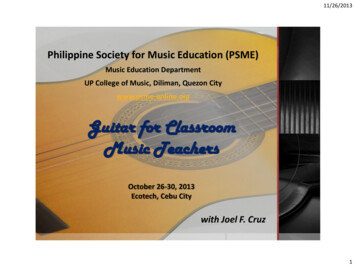
Transcription
11/26/2013Philippine Society for Music Education (PSME)Music Education DepartmentUP College of Music, Diliman, Quezon Citywww.psme-online.orgGuitar for ClassroomMusic TeachersOctober 26-30, 2013Ecotech, Cebu Citywith Joel F. Cruz1
11/26/2013Understanding by Design – Stage 1Standard 2: INSTRUMENTAL PERFORMANCE Students perform on instruments, alone and withothers, a varied repertoire of music.Benchmarks (Grade 2) Perform independently on an instrument. Perform expressively. Perform in groups. Perform music representing the national culture.2
11/26/2013Benchmarks (Grade 8) Perform on an instrument, alone and in small andlarge groups. Perform with expression and technical accuracyon a string, wind, percussion, or classroominstrument. Perform music representing diverse genres andcultures. Play by ear simple melodies on a melodicinstrument and simple accompaniments on aharmonic instrument.3
11/26/2013Essential Questions:Grade 8 How can learning to play a musical instrumentaffect you? How is the guitar used in today’s society? What is the relationship between Music (or Arts)and Culture? In what ways can you use your knowledge andskill in playing a musical instrument?4
11/26/2013Grade 2 Why do you need to learn to play a musicalinstrument? Where and when do you usually see people playguitar? How can learning to play the guitar promote theFilipino Culture? If you know how to play guitar, where, when, orfor whom will you play it? (and why?)5
11/26/2013Enduring Understandings: Students will understand that 1 2 3 4 6
11/26/2013Understanding by Design – Stage 2Performance Task:Grade 2Perform 1 Filipino Folk song of your choice from therepertoire we collected in class.Grade 8Perform 2 Asian Folk songs of your choice from therepertoire we collected in class.7
11/26/2013 The performance may be in any of the following: Alone, in front of the teacher, a panel, OR theclass In a small group, in front of the teacher, a panel,OR the class In a big group, in front of the teacher, a panel,OR the class A rubric for grading will be provided (preferablyahead)8
11/26/2013G.R.A.S.P.S. Goal – impress the panel of judges of a well-knowntalent search by your guitar skills Role – you are an aspiring guitarist Audience – the panel of judges of “TalentadongPinoy” Situation – “Talentadong Pinoy” is an originalFilipino talent search which is aired regularly on TV.They accept applicants for auditions weekly. Afterpassing the pre-screening, they are scheduled toperform in front of a panel of 4 judges who will9
11/26/2013decide whether they go on to the next round/s ornot. You are one of the applicants and yourparticular talent to showcase is playing guitar. Youwill choose the folk song that you can play best. Youcan bring along your friends to play with you. Performance/Product – a solo or small groupguitar performance of a folk song Standards – You will be assessed on the followingcategories: Tone Quality, Pitch, Rhythm, Dynamics,Posture and Relaxation, Attention in class, Practice,and Technique (See rubric)10
11/26/2013Other suggestions for a Performance Task: NAMCYA Contestant Philippine High School for the Arts auditions forscholarship Family Reunion Fiesta Buwan ng Wika celebration Recording artist (Folk song category) EDSA Revolution anniversary Etc.11
11/26/2013Sample Guitar Rubric12
11/26/201313
11/26/2013Other evidences:Formative: Preassessment Seatwork – Parts of the guitar Homework – find a folk song (lyrics and chords) Quiz – important names and terms Self/Peer-assessment of performanceSummative: Knowledge - Mastery test – important names and terms Process – simple song analysis, collaboration, mind-mapping, visualization Understanding – Essay writing (Grade 8) or Interview (Grade 2) EssentialQuestions and other important questions Performance/Product – Performance Task – G.R.A.S.P.S.14
11/26/2013Understanding by Design – Stage 3W.H.E.R.E.T.O. Where: Students will be able to achieve the objectives delineated in Stage1. Hook: From time to time, either the teacher performs a musical piece or asong using the guitar live in front of the class, OR the teacher will show avideo of a good guitar performance, preferably of a guitarist of the sameage range as the students. Equip & Experience: Teach all the basics, the theories, and then let thestudents play with an actual guitar for the most part of the lesson orsemester. Rethink, Reflect, & Revise: Provide reflection sheets for students to fill-up.Use the pre-assessment and formative assessments as tools to inform boththe learner and the teacher on how to revise the lesson. Evaluate: Pre-assessment, Formative assessments, Summative assessments15
11/26/2013 Tailor: Target the students’ readiness levels (ex. Tiering beginner,intermediate, advanced) , interests (Ex. let them choose their favoritesong), and learning style (visual, auditory, kinesthetic-tactile). You mayalso tailor the lesson based on their Multiple Intelligences. Note: Guitar Performance is more of an auditory and tactile activity. Organize: The teacher may prepare a daily or a weekly plan. Anotheroption is to arrange the lessons by topics as follows: Overview of the course The Guitar – name, history, types, parts, strings, tuning The Guitarist – hands, fingers, proper positions The Techniques – Left hand, Right hand The Chords – Chord chart, Key of C, Key of G, Key of F, D, Bb, Am, Em,Dm, Gm The Strumming – down, up, alternating The Plucking – PIMA, PAMI, combi, um-pa etc. The Picking – down, up, alternating16
11/26/2013 The Songs – Filipino Folk Songs, Asian Folk Songs, and Pop Songs Ear training – chord identification The Scales – Major, Minor, C, Am, D, Em, F, Dm, etc. The Melodies – Folk songs17
11/26/2013The Guitar The guitar is a musical instrument characterizedby the following: Made of wood 6 or more strings made of nylon or steel Long-fretted neck Large body with a waist in the middle section A sound hole Played by plucking or strumming18
11/26/2013Brief History Most historians attribute the roots of the guitar to theEuropean “Lute” and the Greek “Kithara”; to the latter due tothe similarity on how the names are pronounced. NoteGreek “Kithara”, Latin “Cithara”, Spanish “Guitarra” andEnglish “Guitar”.GuitarraLuteKithara19
11/26/2013 However, the guitar, lute, and kithara have a lot ofdissimilarities in size and shape. This prompted Dr. MichaelKasha, to retrace the guitar’s origins. According to hisresearch, early instruments with the same characteristics canbe found in Ancient Near-East Asia and India. In fact, thevery first guitar-like instruments, called “Tanburs”, existedmore than 3000 years ago in Egypt. Compare the guitar withthe Persian “Chartar” or “Setar”, and the Indian “Sitar”.ChartarSitar20
11/26/2013 The guitar continued to develop in the Renaissance andBaroque periods. Antonio Stradivarius invented the 5-stringguitar in 1680. George Luis Palermo, on the other hand,created the 6-string guitar in 1832. But it was Antonio TorresJurado, in 1859, who created the style of Spanish guitar as weknow it today. Other guitars like the steel-string, archtop, and jazz guitarswere created afterwards. The guitar found another groundbreaking success when the electric guitar was invented byGeorge Beauchamp and Adolph Rickenbacker. However, itwas Orville Gibson, Les Paul, and Leo Fender who broughtthe electric guitar to greater heights. And the rest is history.21
sonLes PaulFenderGibson22
11/26/20132 Major Classifications:ElectricAcoustic23
11/26/2013Parts of the Guitar 3 Major Parts: Head Neck Body24
11/26/2013HeadScrollTuning keys/pegs(Tuning machines)Nut25
11/26/2013NeckFrets/Fret barsFingerboardStrings26
11/26/2013NeckHeelFret markers27
11/26/2013BodyPurflingRosetteWaistSound holeTop/FaceBridgeSaddle28
11/26/2013BodyBackSide/Rib29
11/26/2013Electric Guitar PartsTuning BridgeWhammy barPick-upsVolume andTone ControlsPick-up selectorPick-guardInput JackCut-away30
11/26/2013Head with locking nutBack and Neckwithout a heel31
11/26/2013StringsD 46 5 4 3 2 13 GA 52 BE 61 EE A D G B E32
11/26/2013How to tune the guitarStandard Tuning - E B G D A E (1 2 3 4 5 6) With another guitar With a pitch pipe With a keyboard With a digital tuner With a website – www.chordbook.com/guitartuner.php With a cellphone or tablet application By itself – press 5th, harmonics, or octaves By ear alone By a combination of some of the above33
11/26/2013How to care for the guitar Do not drop or scratch the guitar Keep it away from wet or moist places Keep it away from dust, food, and drinks Keep it away from too hot or too cold places Keep it in a soft or hard case Do not put heavy objects on the guitar. Do not leave it standing up when not in use. Better to leaveit lying down by its back or side, at the corner of a roomaway from people who may pass by Wipe off the string after usage Do not hit or punch the guitar (and do not use it to hitothers)34
11/26/2013Names of the hands and fingersFor playing guitar31IMA4X0Left HandPDUYAN Print 02 by Joel Cruz2Right Hand35
11/26/2013Proper sitting positionFront viewSide view36
11/26/2013Left Hand Technique Finger 0 should stay at the back, pressing the middle of the neck with itsflesh, NOT the tip Palm should not touch the neck, unless necessary Ex. Bar chords Fingers 1,2,3,4 should be curled forming a letter C Fingers 1,2,3,4 should press the string tightly with the tip of the fingerswhile Finger 0 counters the force from the back. (note: cut your nails) There should be a space in between fingers 1,2,3,4, and 1 fret per finger Fingers 1,2,3,4 should press near the fret, NOT far from the fret, and NOTon the fret Pressing far from the fret will cause the sound to buzz Pressing on the fret will cause the sound to muffle The wrist should be straight Elbow should be slightly away from the body Shoulders relaxed37
11/26/2013Right Hand Technique The palm should be near the sound hole The elbow should be above the rib NOT the waist Relax the fingers, notice the natural positioning of the fingers above thestrings i.e. 1 finger per string Rest Stroke Pluck a string using the tip of the finger and let the finger “rest” on thenext or adjacent string Finger P plucks downward After Finger P plucks String 1, Finger P should rest on the Rosette Fingers I, M, and A pluck upward After Fingers I, M, or A plucks String 6, Finger I, M, or A should rest onthe Rosette Practice by playing each string 4 times per finger38
11/26/2013 Free Stroke Pluck a string and let the finger suspend“freely” without touching the adjacent string All fingers pluck outward in a “hooking” fashionusing the tip of the fingers Practice by playing each string 4 times perfinger Avoid moving the wrist outward, you might loseyour position39
11/26/2013Guitar Chords Chord – 2 or more notes that are usually soundedsimultaneously Broken chord – a chord in which notes aresounded sequentially (NOT simultaneously) Also know as Arpeggio Chord chart – a set of vertical and horizontal linesthat represent part of the guitar neck to illustratehow fingers are to be placed on the guitar40
11/26/2013Comparison6 5 4 3 2 1E A D G B EChord ChartNeck41
11/26/2013Chord Chart LegendX32010 0 open strings, you play themeven though no fingers arepressing them 1,2,3 left hand finger numbers X dead string, do not play it Round shapes/dots showwhich strings and frets to press This is the C Major Chord, intermediate version.42
11/26/2013Key of C Key a family of related notes and chords Key of C I C Major (Tonic)The 3 most importantchords are: ii D minor iii E minor IV F Major V G Major vi A minorAnd its related chord:V7 G Dominant 7th(simply called G7) vii B diminished43
11/26/2013I C Major (C)XXX01Beginner0X3201Intermediate0IIIX 12341Advanced44
11/26/2013IV F Major 5
11/26/2013V7 G Dominant 7th (G7)XXX00Beginner132000IntermediateIII1 312411Advanced46
11/26/2013Chord Progression The way in which chords are arranged in a song Sometimes there is a pattern (ex. Canon in D,Pachelbel), sometimes there is none There should be a minimum of 2 chords(ex. G - Cadd9) The most common chord progressions involve the IIV-V scale degrees of the key Drone – in indigenous music, is the opposite of chordprogression You can try exploring or inventing your own chordprogression47
11/26/2013Bahay KuboCG7 G7CBahay kubo kahit muntiCG7 G7CAnd halaman doon ay sari-sariCG7G7CSingkamas at talong sigarilyas at maniFG7CSitaw bataw patani(do the same chord progression for the next verses)48
11/26/2013CG7 G7CKundol, patola, upo’t kalabasaCG7G7CAt saka mayroon pang labanos mustasaCG7G7CSibuyas, kamatis, bawang at luyaFG7G7CSa paligid-ligid ay maraming linga!(Sa paligid-ligid ay puno ng linga!)49
11/26/2013Key of CX32010 I C Major CXX0231X32011 ii D minor Dm012000 iii E minor Em IV F Major F50
11/26/2013Key of C cont.210034 V G major GX02310 vi A minor AmX2314X vii B diminished Bdim or B 51
11/26/2013Key of G I G Major (Tonic) ii A minor iii B minor IV C Major V D Major vi E minorThe 3 most importantchords are:And its related chord:V7 D Dominant 7th(simply called D7) vii F# diminished52
11/26/2013I G Major (G)XXX00 3221100000 33 4(BeginnerIntermediateIII1 34211)Advanced53
11/26/2013IV C Major (C)XXX01Beginner0X3201Intermediate0IIIX 12341Advanced54
11/26/2013V7 D Dominant 7th (D7)XX021BeginnerXXX021Intermediate3VX 13141Advanced55
11/26/2013Bahay Kubo (transposed)GD7 D7GBahay kubo kahit muntiGD7 D7GAnd halaman doon ay sari-sariGD7D7GSingkamas at talong sigarilyas at maniCD7GSitaw bataw patani(do the same chord progression for the next verses)56
11/26/2013GD7 D7GKundol, patola, upo’t kalabasaGD7D7GAt saka mayroon pang labanos mustasaGD7D7GSibuyas, kamatis, bawang at luyaCD7D7GSa paligid-ligid ay maraming linga!(Sa paligid-ligid ay puno ng linga!)57
11/26/2013Leron, Leron SintaGD7Leron, Leron Sinta, buko ng papayaD7GDala-dala’y buslo, sisidlan ng bungaGG7CPagdating sa dulo nabali ang sangaCGD7GKapus kapalaran humanap ng iba(do the same chord progression for the next verses)58
11/26/2013Halika na Neneng, tayo’y manampalokDalhin mo ang buslo, sisidlan ng hinogPagdating sa dulo’y uunda-undayogKumapit ka Neneng, baka ka mahulog.59
11/26/2013Halika na Neneng at tayo’y magsimbaAt iyong isuot ang baro mo’t sayaAng baro mo’t sayang pagkaganda-gandaKay ganda ng kulay — berde, puti, pula.Ako’y ibigin mo, lalaking matapangAng baril ko’y pito, ang sundang ko’y siyamAng lalakarin ko’y parte ng dinulangIsang pinggang pansit ang aking kalaban.60
11/26/2013Pentatonic Scale It is a scale with only 5 tones Penta 5 Tonic tone/s Very common in Asian cultures (Philippines,China, Japan, Korea, etc.) In the Key of C: Do Re Mi Sol La (Do) C D E G A (C) Do Re Fa Sol La (Do) Rare61
11/26/2013Letter names on the fingerboard62
11/26/2013 In the Key of G: (Pentatonic) Sol La Ti Re Mi (Sol) GAB DE(G)63
11/26/2013 In the Key of F: (Pentatonic) Fa Sol La Do Re (Fa) FGA CD(F)64
11/26/20133Key of G20003 I G Major GX02310X32010 ii A minor AmII 013421 iii B minor Bm IV C Major C65
11/26/2013Key of G cont.X X0132 V D major D012000 vi E minor EmVIIIX 2314X vii F# diminished F#dim or F# 66
11/26/2013Key of GDrone or Chord m7BD7AEm7DGGCM7AGEDCM7EGABABGCM7GEDEGD (E)GAEGD7GDED (E)GAGG67
11/26/201368
11/26/201369
11/26/2013Key of F I F Major (Tonic) ii G minor iii A minor IV Bb Major V C Major vi D minorThe 3 most importantchords are:And its related chord:V7 C Dominant 7th(simply called C7) vii E diminished70
11/26/2013I F Major 1
11/26/2013IV Bb Major 72
11/26/2013V7 C Dominant 7th (C7)XXX31Beginner0X3241Intermediate0IIIX 12141Advanced73
11/26/2013Paru-parong bukidBb-F-C7-FFC7Paruparong bukid na lilipad-lipadC7FSa gitna ng daan papagapagaspasF(F7)BbIsang bara ang tapis, isang dangkal ang manggasBbFC7FAng sayang de kola Isang piyesa ang sayad74
11/26/2013C7May payneta pa siya — uy!,FMay suklay pa man din — uy!C7FNagwas de-ohetes ang palalabasinC7FHaharap sa altar at mananalaminBbFC7FAt saka lalakad nang pakendeng-kendeng.75
11/26/2013Key of F134211 I F Major FIII1 34111X2341 ii G minor GmX02310 iii A minor Am1 IV Bb Major Bb76
11/26/2013Key of F cont.X32010 V C major CXX0231 vi D minor DmVIX 2314X vii E diminished Edim or E 77
11/26/2013Relative minor key A key that has the same set of notes and chordswith its Relative major A minor third below (or a major sixth above) theRelative major By looking at the Major scale degree, the relativeminor key starts with the scale degree vi Ex. Key of C I,ii,iii, IV, V, vi, vii , (VIII) C, Dm, Em, F, G, Am, B , (C)78
11/26/2013A minor key Ex. Key of C I,ii,iii, IV, V, vi, vii , (VIII) C, Dm, Em, F, G, Am, B , (C) Am key scale degrees i,ii , III, Am, B , C,iv,v, VI, VII, (i)Dm, Em, F,G, (Am) Am key scale degrees (harmonic alternative) i,ii , III, Am, B , C,iv,Dm,V, VI, VII, (i)E,F,G, (Am)79
11/26/2013A minor pentatonic scale La Ti Do Mi Fa (La) ABCEF(A)80
11/26/2013E minor key Key of G I,ii,iii, IV, V, vi, vii , (VIII) G, Am, Bm, C, D, Em, F# , (G) Em key scale degrees i,ii , III, Em, F# , G,iv,v, VI, VII, (i)Am, Bm, C,D, (Em) Em key scale degrees (harmonic alternative) i,ii , III, Em, F# , G,iv,Am,V, VI, VII, (i)B, C,D, (Em)81
11/26/2013E minor pentatonic scale Mi Fa# Sol Ti Do (Mi) EF#GBC(E)82
11/26/2013D minor key Key of F I,ii,iii, IV, V, vi, vii , (VIII) F, Gm, Am, Bb, C, Dm, E , (F) Dm key scale degrees i,ii , III, Dm, E , F,iv,v, VI, VII, (i)Gm, Am, Bb, C, (Dm) Dm key scale degrees (harmonic alternative) i,ii , III, Dm, E , F,iv,Gm,V, VI, VII, (i)A, Bb, C, (Dm)83
11/26/2013D minor pentatonic scale Re Mi Fa La Ti (Re) DEFA Bb (D)84
11/26/2013Key of AmAmAAmABAmECEBFECEFEE C BBABCBEC BAB A FDmABCAmE(7)FDmAmEDmEAEAmEAAmAABAEAmBAB A FEABAm(9)AFE85
11/26/201386
11/26/2013Suggestions in the use of chords Grade 2 or Beginner students may just use the IIV-V (V7) scale degree chords Grade 8 or Intermediate students may use the ii,iii, and vi scale degree chords Higher grades or Advanced students may use vii scale degree chord, and m7, M7, dim, and augchords Professional or Jazz players may use 6, 9, 11, 13,etc. chords Create a goal for yourself (or your students)87
11/26/2013Strumming You can use: the P finger only (flesh & nail) the I finger only (nail & flesh) the I, M, A fingers only (nail & flesh) a combination P and I (nail) a combination of P and I,M,A (nail) a pick88
11/26/2013Strumming patterns In 1,2,3 or 4 down, down, down, down (Ex. Rock) up, up, up, up (Ex. Pop, Reggae) In 2 or 4 down, up, down, up In 3 or 6 down, up, up, down, up, up down, up, down – down, up, down89
11/26/201390
11/26/2013Plucking patterns P I M AP A M IP I M IP M A MP I A IP I M A M IP I M A I MP I M I A I M ITry to fit the plucking pattern with the number ofbeats that the song has Ex. 2,3,or 4 beats91
11/26/2013UsahayF – D/F# - C/G – A7 – Dm7 – G7(add6)C – G7-/A-/BCG7C CM7Usahay magadamgo akoC7A7 Dm7 A7 5Nga ikaw ug ako nagka higugmaayDm7 A7 5Dm7 A7 5Nganong damgohon ko ikawG7G7 5 CM7G7-/A-/BDamgohon sa kanunay sa akong kamingaw92
11/26/2013CG7CM7G7Usahay magamahay akoGm7C7 FNganong nabuhi pa ning kalibutanFM7 D/F#C/G A7Nganong gitiawtiawanDm7G7(add6) C G7-/A-/BAng gugma ko kanimo, kanimoda(Repeat all)Gm7-C7 – “ Ngano”93
11/26/2013References: Online Guide E-Guitars - Thomann Polska. (n.d.). Online Guide E-Guitars - Thomann Polska.Retrieved October 22, 2013, from http://www.thomann.de/pl/onlineexpert 90 4.html Guy, P. (n.d.). A Brief History of the Guitar. A Brief History of the Guitar. Retrieved October22, 2013, from y.html Wiggins, G., & McTighe, J. (2005). Overview of UbD and the Design Template.Understanding by Design:, n/a, 1-14. Retrieved October 1, 2013, ue1005.pdf Arirang. (2013, October 24). Wikipedia. Retrieved October 26, 2013, fromhttp://en.wikipedia.org/wiki/Arirang Sakura Sakura. (2013, August 30). Wikipedia. Retrieved October 27, 2013, fromhttp://en.wikipedia.org/wiki/Sakura Sakura "Philippine Folk Songs: Lyrics." Philippine Folk Songs Lyrics. N.p., 29 Sept. 2009. Web. 28Oct. 2013. 9/leron-leron-sinta/ . Sa ugoy ng duyan94
11/26/2013External links: Lute - Retrieved October 22, 2013 fromhttp://www.google.com.ph/url?sa i&source images&cd &cad rja&docid CfIo5yip4yTrmM&tbnid P9UMguPF2LwJLM:&ved 0CAgQjRwwAA&url ute.jpg&ei 2qVmUs6tN5GQiAeUqoHADQ&psig AFQjCNH dXrrkIbf0FW506rGh82uHhr1RQ&ust 1382545242996952 Kithara – Retrieved October 22, 2013 fromhttp://www.google.com.ph/url?sa i&source images&cd &cad rja&docid 9dNcM6nggv6D M&tbnid kL5WutrAhJ2ZWM:&ved 0CAgQjRwwAA&url http%3A%2F%2Fwww.thomann.de%2Fpl%2Fonlineexpert 90 4.html&ei rqVmUvG8MKSZiAfOhIHoDQ&psig AFQjCNHEIuTryWwUYRinWwFn64A6vQ7XSQ&ust 1382545198912798 Chartar – Retrieved October 22, 2013 from http://www.google.com.ph/url?sa i&source images&cd &cad rja&docid J7peSPkCvSNoM&tbnid hzAeExLsj3cFuM:&ved 0CAgQjRwwAA&url FBriefHistory.html&ei xqJmUsjCPIToiAe404HIDw&psig AFQjCNHWHxQT0Q5bpkYs8M9VXJ2ljylM g&ust 1382544455106513 Sitar – Retrieved October 22, 2013 from http://www.google.com.ph/url?sa i&source images&cd &cad rja&docid G4Tggt5311dKM&tbnid jUZwtbmRjH7JHM:&ved 0CAgQjRwwAA&url nsonline-school-music-classes.php&ei 3KJmUrTPBcaQiAe55IDoAw&psig AFQjCNHARIGfNOMmzutUg2bcBvX ldc8Q&ust 1382544476210718 Renaissance Guitar – Retrieved October 22, 2013 fromhttp://www.google.com.ph/url?sa i&source images&cd &cad rja&docid wH7otlxnGIJtLM&tbnid wTjFZ6Utcg7SfM:&ved 0CAgQjRwwADgm&url N05%2F6150381429%2F&ei bchmUpe0EqqKiQeyzIGgBw&psig AFQjCNFOCk U8claNM6SUixNkaKN1kohhw&ust 1382554093394584 Baroque Guitar – Retrieved October 22, 2013 fromhttp://www.google.com.ph/url?sa i&source images&cd &cad rja&docid 7WU2gdZT7iHilM&tbnid iD6BIqp93hV8dM:&ved 0CAgQjRwwAA&url F06%2Fbaroque-guitar-forsmarties%2F&ei TMhmUt6eC-TtiAeNiYHwBw&psig AFQjCNGjMye7Q6yvdZMfeI5xdEypN kIdg&ust 1382554060267488 Steel-string Guitar – Retrieved October 22, 2013 fromhttp://www.google.com.ph/url?sa i&source images&cd &cad rja&docid saxUXz7LtHNuSM&tbnid VKDk2NfvowXFkM:&ved 0CAgQjRwwAA&url http%3A%2F%2Fguitaristguitarist.com%2Ftypes of guitar.html&ei j8hmUsv4Ec2ViQe8kIC4Dw&psig AFQjCNHoPBEfAjXvGiqeM AAO-SHAwJTOw&ust 1382554127385724 Archtop Guitar – Retrieved October 22, 2013 fromhttp://www.google.com.ph/url?sa i&source images&cd &cad rja&docid okpuT6rIlsLxDM&tbnid KKXen 9REysbQM:&ved 0CAgQjRwwAA&url http%3A%2F%2Fwww.reedeguitars.com%2Farchtop.htm&ei xMhmUueXKai1iQfv14CADQ&psig AFQjCNGsJWr8Y-E7 oO2TzTdzijb7mSwRA&ust 138255418076170995
11/26/2013 Gibson Guitar – Retrieved October 22, 2013 fromhttp://www.google.com.ph/url?sa i&source images&cd &cad rja&docid jlXfYvARLISMoM&tbnid b5V UmQSYGMVM:&ved 0CAgQjRwwAA&url c%2Finstruments%2Fguitars%2F&ei 7MhmUuCvHKT iAedyYDQAg&psig AFQjCNFMAujoVO6ifbeQfxBfCgCmPCGjUQ&ust 1382554220553143 Gibson Les Paul Guitar – Retrieved October 22, 2013 fromhttp://www.google.com.ph/url?sa i&source images&cd &cad rja&docid ZClSHiP24QEPM&tbnid 53B7pB3xQu3CyM:&ved 0CAgQjRwwAA&url string-aguitar%2F&ei 48hmUq6BPMaciAehlIHoCw&psig AFQjCNHDyXzhGXNx80LguTanL k1mkAgMg&ust 1382554212107876 Fender Guitar – Retrieved October 22, 2013 fromhttp://www.google.com.ph/url?sa i&source images&cd &cad rja&docid frJZVUSJgpjg9M&tbnid EPMLrBG6fdt2PM:&ved 0CAgQjRwwAA&url 2F&ei FslmUraXMoP-iAfHjoGYDw&psig AFQjCNG-v7aXQTFApNhLb1EkSNhId2oClw&ust 1382554262910955 Pitch Pipe – Retrieved October 24, 2013 fromhttp://www.google.com.ph/url?sa i&source images&cd &cad rja&docid ljhWfGOW0vZwJM&tbnid VZ7WHKInjGsyM:&ved 0CAgQjRwwADiIAg&url -traps-of-using-key-notationsoftware%2F&ei EPVoUtfRI7GaiAfl24HQDw&psig AFQjCNECsG18gjrCIGYV57Ldj8ue1DvXVg&ust 1382696592665690 The Ultimate Guitar Chord Chart – Retrieved October 26, 2013 fromhttp://www.google.com.ph/url?sa i&source images&cd &cad rja&docid CBdays6bZtb7kM&tbnid 7jK940ICeaVpdM:&ved 0CAgQjRwwAA&url ei NBFsUte9HZDMigKakoDwBA&psig AFQjCNFydFSbbhLYaBS bdKlxxYzwtgXYw&ust 1382900404538204 Arirang – Retrieved October 26, 2013 from http://www.google.com.ph/url?sa i&source images&cd &cad rja&docid Sn L0zzWpWjoM&tbnid xevg4phiPg0jM:&ved 0CAgQjRwwADgh&url F02%2Fasian-folksongs.html&ei DzZsUuSQEbGTiQepzYDACQ&psig AFQjCNEql8ZaoDdwWgEN7JFO0L5aDPFfrw&ust 1382909839395636 Names of the notes on the neck – Retrieved October 27, 2013 fromhttp://www.google.com.ph/url?sa i&source images&cd &cad rja&docid goDC9UPMcYBzOM&tbnid WAdiwWxHWpANEM:&ved 0CAgQjRwwAA&url names%2F&ei 8WlsUsiPMOnZigfKq4HABw&psig AFQjCNH9cbt1-5DwxjQug7JpUIjuEH8t7w&ust 1382923121909021 Sakura – Retrieved October 28, 2013 from /Sakura.song.png Hava Nagila – Retrieved October 29, 2013 fromhttp://www.google.com.ph/url?sa i&source images&cd &cad rja&docid YlN3AHLMmL3IM&tbnid ad9q2tNkEOnBiM:&ved 0CAgQjRwwAA&url on%3Dfr%26img%3D1%26adv%3D1&ei kBJvUp6UK87akgW10oDIBg&psig AFQjCNHX6Sz6JH3OQBJcERby3DjlyRI0wg&ust 138309736076357096
created the 6-string guitar in 1832. But it was Antonio Torres Jurado, in 1859, who created the style of Spanish guitar as we know it today. Other guitars like the steel-string, archtop, and jazz guitars were created afterwards. The guitar found another ground-breaking success

